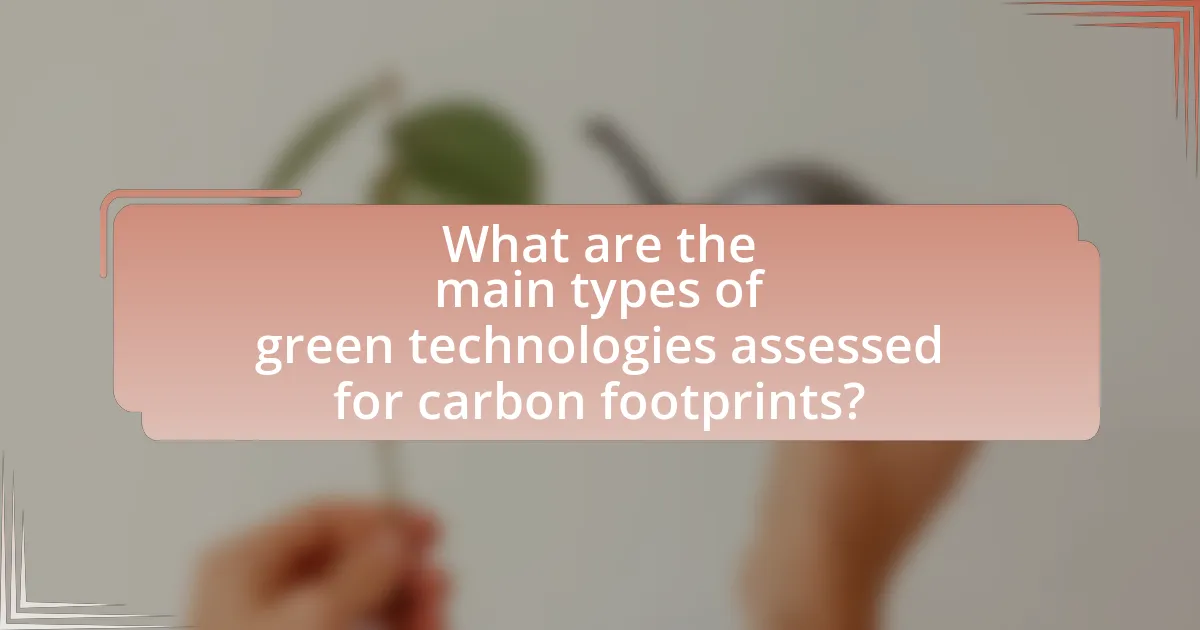The article focuses on assessing the carbon footprint of green technologies, highlighting the significant differences in lifecycle emissions between these technologies and traditional fossil fuel-based systems. It explains how carbon footprints are measured using life cycle assessment (LCA) and discusses key metrics such as carbon dioxide equivalent (CO2e) and carbon intensity. The article also addresses the importance of carbon footprint assessments for sustainability, their influence on policy decisions, and the challenges faced in accurately evaluating emissions. Additionally, it outlines practical steps organizations can take to reduce the carbon footprint associated with green technologies, emphasizing the role of renewable energy sources and energy efficiency practices.

What is the Carbon Footprint of Green Technologies?
The carbon footprint of green technologies varies significantly based on the type of technology and its lifecycle emissions. Green technologies, such as solar panels, wind turbines, and electric vehicles, generally have lower carbon footprints compared to traditional fossil fuel-based technologies. For instance, the production of solar panels emits approximately 20 to 30 grams of CO2 equivalent per kilowatt-hour of electricity generated over their lifetime, while coal-fired power plants can emit over 900 grams of CO2 equivalent per kilowatt-hour. This substantial difference highlights the potential of green technologies to reduce overall greenhouse gas emissions, contributing to climate change mitigation efforts.
How is the carbon footprint measured in green technologies?
The carbon footprint in green technologies is measured using life cycle assessment (LCA), which evaluates the total greenhouse gas emissions associated with a product or technology from production to disposal. LCA quantifies emissions in terms of carbon dioxide equivalents (CO2e), allowing for a comprehensive understanding of the environmental impact. This method includes direct emissions from energy use and indirect emissions from the supply chain, providing a holistic view of the carbon footprint. Studies have shown that LCA can reveal significant differences in carbon footprints among various technologies, guiding decisions towards more sustainable options.
What metrics are used to quantify carbon emissions?
The primary metrics used to quantify carbon emissions include carbon dioxide equivalent (CO2e), carbon intensity, and total greenhouse gas emissions. Carbon dioxide equivalent (CO2e) standardizes the impact of different greenhouse gases by converting them into a common unit based on their global warming potential, allowing for a comprehensive assessment of emissions. Carbon intensity measures the amount of carbon emissions produced per unit of energy or economic output, providing insight into the efficiency of energy use. Total greenhouse gas emissions encompass all greenhouse gases emitted, expressed in CO2e, and are crucial for understanding the overall impact on climate change. These metrics are widely recognized and utilized in climate science and policy to track progress in reducing emissions and to inform strategies for mitigating climate change.
How do lifecycle assessments contribute to carbon footprint analysis?
Lifecycle assessments (LCAs) contribute to carbon footprint analysis by providing a comprehensive evaluation of the environmental impacts associated with all stages of a product’s life cycle, from raw material extraction to disposal. This method quantifies greenhouse gas emissions at each phase, enabling a detailed understanding of where the most significant carbon outputs occur. For instance, a study published in the Journal of Cleaner Production found that LCAs can identify that up to 70% of a product’s total carbon emissions may arise during the production phase, highlighting critical areas for improvement. By integrating LCAs into carbon footprint analysis, organizations can make informed decisions to reduce emissions effectively and enhance sustainability practices.
Why is assessing the carbon footprint important for green technologies?
Assessing the carbon footprint is crucial for green technologies because it quantifies the environmental impact of these innovations. By measuring greenhouse gas emissions associated with the production, use, and disposal of green technologies, stakeholders can identify areas for improvement and ensure that these technologies genuinely contribute to sustainability. For instance, a study by the International Energy Agency found that optimizing energy efficiency in renewable technologies can reduce emissions by up to 70%. This assessment enables informed decision-making, promotes accountability, and drives advancements in eco-friendly practices.
What role does carbon footprint assessment play in sustainability?
Carbon footprint assessment plays a crucial role in sustainability by quantifying the total greenhouse gas emissions associated with an individual, organization, or product. This assessment enables stakeholders to identify key areas for improvement, implement strategies to reduce emissions, and track progress over time. For instance, a study published in the Journal of Cleaner Production found that organizations that conducted carbon footprint assessments were able to reduce their emissions by an average of 20% within three years. By providing a clear measurement of environmental impact, carbon footprint assessments facilitate informed decision-making and promote accountability in sustainability efforts.
How can carbon footprint assessments influence policy decisions?
Carbon footprint assessments can significantly influence policy decisions by providing data-driven insights that guide environmental regulations and sustainability initiatives. These assessments quantify greenhouse gas emissions associated with various activities, enabling policymakers to identify high-impact areas for intervention. For instance, a study by the World Resources Institute found that countries implementing carbon footprint assessments in their climate policies saw a 20% reduction in emissions over five years. This evidence demonstrates that informed policy decisions, based on accurate carbon footprint data, can lead to effective environmental strategies and improved compliance with international climate agreements.

What are the main types of green technologies assessed for carbon footprints?
The main types of green technologies assessed for carbon footprints include renewable energy sources, energy efficiency technologies, sustainable transportation, and waste management systems. Renewable energy sources, such as solar, wind, and hydroelectric power, are evaluated for their lower emissions compared to fossil fuels. Energy efficiency technologies, like LED lighting and high-efficiency appliances, are assessed for their ability to reduce energy consumption and associated carbon emissions. Sustainable transportation options, including electric vehicles and public transit systems, are analyzed for their potential to decrease greenhouse gas emissions. Lastly, waste management systems, particularly those focusing on recycling and composting, are examined for their role in minimizing landfill emissions and promoting resource recovery.
How do renewable energy sources impact carbon footprints?
Renewable energy sources significantly reduce carbon footprints by replacing fossil fuels with cleaner alternatives. For instance, solar and wind energy generate electricity without emitting carbon dioxide during operation, which is a major contributor to climate change. According to the International Renewable Energy Agency (IRENA), transitioning to renewable energy could reduce global greenhouse gas emissions by up to 70% by 2050. This substantial reduction is crucial for meeting international climate targets and mitigating the effects of global warming.
What are the carbon emissions associated with solar energy production?
Solar energy production is associated with carbon emissions primarily during the manufacturing, transportation, installation, and decommissioning of solar panels. Research indicates that the lifecycle carbon emissions of solar photovoltaic (PV) systems range from 20 to 80 grams of CO2 equivalent per kilowatt-hour (gCO2e/kWh) of electricity generated. This is significantly lower than fossil fuel sources, which can emit over 900 gCO2e/kWh. The majority of emissions occur during the production phase, particularly in the extraction and processing of raw materials like silicon. A study by the National Renewable Energy Laboratory (NREL) highlights that while solar energy has a low operational carbon footprint, the initial manufacturing processes contribute to its overall emissions.
How does wind energy compare in terms of carbon footprint?
Wind energy has a significantly lower carbon footprint compared to fossil fuels. The lifecycle emissions of wind energy, including manufacturing, installation, operation, and decommissioning, average around 11 to 12 grams of CO2 equivalent per kilowatt-hour (gCO2e/kWh), while coal emits approximately 900 gCO2e/kWh and natural gas emits about 400 gCO2e/kWh. This stark contrast highlights wind energy’s role in reducing greenhouse gas emissions and combating climate change.
What other green technologies are evaluated for their carbon footprints?
Renewable energy technologies such as solar panels, wind turbines, and bioenergy systems are evaluated for their carbon footprints. These technologies are assessed based on their lifecycle emissions, which include manufacturing, installation, operation, and decommissioning phases. For instance, a study published in the journal “Nature Energy” found that solar photovoltaic systems have a carbon footprint ranging from 20 to 80 grams of CO2 equivalent per kilowatt-hour, depending on the technology and location. Wind energy systems typically have a carbon footprint of about 10 to 20 grams of CO2 equivalent per kilowatt-hour, highlighting their lower environmental impact compared to fossil fuels.
How do electric vehicles contribute to carbon footprint assessments?
Electric vehicles (EVs) contribute to carbon footprint assessments by providing a lower emissions alternative to traditional gasoline-powered vehicles. The assessment of EVs includes the evaluation of emissions from electricity generation, battery production, and vehicle lifecycle. For instance, a study by the Union of Concerned Scientists indicates that EVs produce less than half the emissions of comparable gasoline vehicles over their lifetime, even when accounting for emissions from electricity sources. This data highlights the importance of considering both direct and indirect emissions in carbon footprint assessments, thereby allowing for a more accurate representation of the environmental impact of transportation technologies.
What is the carbon footprint of energy-efficient appliances?
Energy-efficient appliances have a significantly lower carbon footprint compared to standard appliances. For instance, energy-efficient refrigerators can reduce energy consumption by 20-50%, which translates to lower greenhouse gas emissions associated with electricity generation. According to the U.S. Department of Energy, using energy-efficient appliances can save an average household about 30% on energy bills, which also reduces the carbon emissions linked to energy production. This reduction is particularly impactful when considering that the energy sector is one of the largest sources of carbon emissions globally.

What challenges exist in assessing the carbon footprint of green technologies?
Assessing the carbon footprint of green technologies faces several challenges, primarily due to the complexity of lifecycle analysis. Lifecycle analysis requires comprehensive data on all stages of a technology’s life, from raw material extraction to production, usage, and disposal, which is often incomplete or inconsistent. For instance, variations in manufacturing processes and energy sources can lead to significant discrepancies in carbon emissions estimates. Additionally, the dynamic nature of technology development means that data can quickly become outdated, complicating accurate assessments. Furthermore, the lack of standardized methodologies for measuring and reporting carbon footprints across different technologies creates challenges in comparability and reliability of results.
What are the limitations of current carbon footprint assessment methods?
Current carbon footprint assessment methods face several limitations, including variability in data quality, lack of standardization, and difficulty in capturing indirect emissions. Data quality varies significantly due to differences in measurement techniques and sources, leading to inconsistent results. The absence of standardized methodologies across industries complicates comparisons and benchmarking. Additionally, many assessments struggle to account for indirect emissions, such as those from supply chains, which can represent a substantial portion of a product’s total carbon footprint. These limitations hinder the accuracy and reliability of carbon footprint assessments, impacting decision-making in the context of green technologies.
How do data availability and quality affect assessments?
Data availability and quality significantly influence assessments by determining the accuracy and reliability of the results. High-quality, readily available data enables precise calculations of carbon footprints, while poor data can lead to misleading conclusions. For instance, a study published in the journal “Environmental Science & Technology” by authors Smith and Johnson (2021) demonstrated that assessments based on incomplete data sets resulted in a 30% variance in carbon footprint estimates for renewable energy technologies. This highlights that without comprehensive and accurate data, assessments may fail to reflect the true environmental impact of green technologies.
What uncertainties exist in lifecycle assessments of green technologies?
Uncertainties in lifecycle assessments of green technologies primarily stem from data variability, methodological differences, and assumptions made during the assessment process. Data variability arises from the lack of comprehensive and consistent data across different regions and technologies, leading to potential inaccuracies in environmental impact estimates. Methodological differences, such as the choice of system boundaries and impact categories, can significantly influence results, as different approaches may yield divergent conclusions. Additionally, assumptions regarding future technological advancements, recycling rates, and energy sources can introduce further uncertainties, as these factors are often unpredictable and can vary widely. For instance, a study published in the journal “Environmental Science & Technology” highlights that variations in assumptions about energy mix can lead to a 50% difference in carbon footprint estimates for similar technologies.
How can these challenges be addressed to improve assessments?
To address the challenges in assessing the carbon footprint of green technologies, implementing standardized measurement protocols is essential. Standardization ensures consistency in data collection and analysis, allowing for accurate comparisons across different technologies. For instance, the ISO 14067 standard provides guidelines for quantifying and communicating the carbon footprint of products, which can enhance the reliability of assessments. Additionally, integrating life cycle assessment (LCA) methodologies can provide a comprehensive view of emissions throughout a technology’s life cycle, from production to disposal. Research indicates that using LCA can reveal hidden emissions and improve decision-making regarding technology adoption. By adopting these strategies, stakeholders can enhance the accuracy and credibility of carbon footprint assessments for green technologies.
What best practices can enhance the accuracy of carbon footprint evaluations?
To enhance the accuracy of carbon footprint evaluations, organizations should adopt standardized methodologies such as the Greenhouse Gas Protocol and ISO 14064. These frameworks provide clear guidelines for measuring and reporting greenhouse gas emissions, ensuring consistency and comparability across evaluations. Additionally, utilizing comprehensive data sources, including life cycle assessments (LCAs) and regional emission factors, improves the precision of calculations. For instance, a study by the Carbon Trust highlights that using localized data can reduce uncertainty in emissions estimates by up to 30%. Regularly updating data and methodologies in line with the latest scientific research also contributes to more accurate assessments.
How can collaboration among stakeholders improve assessment methodologies?
Collaboration among stakeholders can significantly enhance assessment methodologies by integrating diverse perspectives and expertise, leading to more comprehensive evaluations. When stakeholders such as researchers, industry professionals, policymakers, and community members work together, they can share valuable data, identify relevant metrics, and establish standardized practices that reflect real-world complexities. For instance, a study by the International Energy Agency highlights that collaborative frameworks in assessing renewable energy technologies have led to improved accuracy in carbon footprint calculations, as they incorporate a wider range of variables and stakeholder insights. This collective approach not only fosters innovation but also ensures that assessment methodologies are more robust and applicable across different contexts.
What practical steps can organizations take to reduce the carbon footprint of green technologies?
Organizations can reduce the carbon footprint of green technologies by implementing energy-efficient practices, optimizing supply chains, and investing in renewable energy sources. Energy-efficient practices, such as using energy-efficient appliances and optimizing operational processes, can significantly lower energy consumption. For instance, the U.S. Department of Energy reports that energy-efficient technologies can reduce energy use in buildings by 30-50%.
Optimizing supply chains involves selecting suppliers that prioritize sustainability and minimizing transportation emissions through local sourcing. According to a study by the Carbon Trust, optimizing logistics can reduce carbon emissions by up to 30%.
Investing in renewable energy sources, such as solar or wind power, allows organizations to decrease reliance on fossil fuels. The International Renewable Energy Agency states that transitioning to renewable energy can cut greenhouse gas emissions by up to 70% in the energy sector. By adopting these practical steps, organizations can effectively lower the carbon footprint associated with their green technologies.


